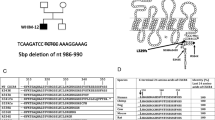Abstract
A Turkish patient with C1q deficiency presented with a lupus-like disease, and a new missense mutation at A chain is presented. To characterize the genetic defect, all exons of the genes for the A, B, and C chains of C1q were sequenced in the patient. This revealed a missense mutation in the collagen-like domain of the A chain, p.Gly31Arg. No other sequence variants, including the common silent mutations, were found in the three chains. Exon 1 of the C1q A chain was sequenced in 105 samples from healthy controls for this particular mutation. None of these carried the mutation. The C1q-deficient patient was treated with fresh frozen plasma infusions. Our findings showed that Turkish patients may have different mutations than the previously described common mutation, and once again, not only nonsense mutations but also missense mutations cause hereditary C1q deficiency. Regular fresh frozen plasma infusions to the patient have been clinically and therapeutically successful.


Similar content being viewed by others
References
Bowness P, Davies KA, Norsworthy PJ, Athanassiou P, Taylor-Wiedman J, Borysiewicz LK, Meyer PA, Walport MJ (1994) Hereditary C1q deficiency and SLE: case report and review of the literature. Q J Med 87:455–464
Walport MJ (2001) Complement. First of two parts. N Engl J Med 344:1058–1066
Walport MJ (2001) Complement. Second of two parts. N Engl J Med 344:1140–1144
Botto M, Dell' Agnola C, Bygrave AE, Thompson EM, Cook HT, Petry F, Loos M, Pandolfi PP, Walport MJ (1998) Homozygous C1q deficiency causes glomerulonephritis associated with multiple apoptotic bodies. Nat Genet 19:56–59
Topaloglu R, Bakkaloglu A, JH Slingsby J, Mihatsch M, Pascaul M, Norsworthy P, Morley BJ, Saatci U, Schifferli JA, Walport MJ (1996) Molecular basis of hereditary C1q deficiency associated with SLE and Ig A nephropathy in a Turkish Family. Kidney Int 50:635–642
JH Slingsby J, Norsworthy P, Pearce G, Vaishnay AK, Issler H, Morley BJ, Walport MJ (1996) Homozygous hereditary C1q deficiency and systemic lupus erythematosus. Arhritis Rheum 39:663–670
Petry F, Berkel AI, Loos M (1997) Multiple identification of a particular type of hereditary C1q deficiency in the Turkish population: review of the cases and additional genetic and functional analysis. Hum Genet 100:51–56
McAdam RA, Goundis D, Reid KB (1988) A homozygous point mutation results in a stop codon in the C1q B chain of a C1q deficient individual. Immunogenetics 27:259–264
Sun-Tan C, Ozgür TT, Kilinç G, Topaloglu R, Gököz O, Ersoy-Evans S, Sanal O (2010) Hereditary C1q deficiency: a new family with C1qA deficiency. Turk J Pediatr 52(2):184–186
Petry D, Le DT, Kirschfink M, Loos M (1995) Nonsense and missense mutations in the structural genes of complement component C1q A and C chains are linked with two different types of complete selective C1q deficiencies. J Immunol 155:4734–4738
Marquart HV, Schejbal L, Sjoholm A, Martensson U, Nielsen S, Koch A, Svejgaard A, Garred P (2007) C1q deficiency in an Inuit family: identification of a new class of C1q disease-causing mutations. Clin Immunol 124:33–40
Gulez N, Genel F, Atlihan F, Gullstrand B, Skattum L, Schejbel L, Garred P, Truedsson L (2010) Homozygosity for a novel mutation in the C1q gene in a Turkish family with hereditary C1q deficiency. J Investig Allergol Clin Immunol 20:255–258
Mehta P, Norsworthy PJ, Hall AE, Kelly SJ, Walport MJ, Botto M, Pickering MC (2010) SLE with C1q deficiency treated with fresh frozen plasma: a 10 year experience. Rheumatology (Oxford) 49(4):823–824
Schejbel L, Skattum L, Hagelberg S, Ahlin A, Schiller B, Berg S, Genel F, Truedsson L, Garred P (2011) Molecular basis of hereditary C1q deficiency-revisited: identification of several novel disease causing mutations. Genes Immun 12:626–634
Topaloglu R, Bakkaloglu A, Slingsby JH, Aydintug O, Besbas N, Saatci U, Walport MJ (2000) Survey of Turkish systemic lupus erythematosus patients for a particular mutation of C1Q deficiency. Clin Exp Rheumatol 18:75–77
Mayer MM (1961) Complement and complement fixation. In: Kabat EA (ed) Experimental immunochemistry. Charles C. Thomas, Springfield, pp 133–158
Manderson AP, Pickering MC, Botto M, Walport MJ, Parish CR (2001) Continual low level activation of the classical complement pathway. J Exp Med 194:747–756
Botto M, Kirschfink M, Macor P, Pickering MC, Würzner R, Tedesco F (2009) Complement in human diseases: lessons from complement deficiencies. Mol Immunol 46:2774–2783
Petry F, Botto M, Holtappels R, Walport MJ, Loos M (2001) Reconstitution of the complement function in C1q deficient (C1qa (-/-) mice with wild type bone marrow cells. J Immunol 167:4033–4037
Erlendsson K, Traustadottir K, Freysdottir J, Steinsson K, Jonsdottir I, Valdimarsson H (1993) Reciprocal changes in complement activity and immune complex levels during plasma infusion in a C2 deficient SLE patient. Lupus 2:1616–165
Hudson-Peacock MJ, Joseph SA, Cox J, Muro CS, Simpson NB (1997) Systemic lupus erythematosus complicating complement type 2 deficiency: successful treatment with fresh frozen plasma. Br J Dermatol 136:388–392
Disclosures
None.
Author information
Authors and Affiliations
Corresponding author
Rights and permissions
About this article
Cite this article
Topaloglu, R., Taskiran, E.Z., Tan, C. et al. C1q deficiency: identification of a novel missense mutation and treatment with fresh frozen plasma. Clin Rheumatol 31, 1123–1126 (2012). https://doi.org/10.1007/s10067-012-1978-4
Received:
Revised:
Accepted:
Published:
Issue Date:
DOI: https://doi.org/10.1007/s10067-012-1978-4




